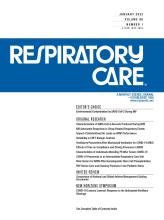The COVID-19 pandemic has taught us a lot. One vital lesson learned by the respiratory community has been differentiating the risks of aerosol transmission and the classification of aerosol-generating procedures (AGPs).
During the early pandemic, several experimental studies reported live virus from aerosols and surfaces hours after inoculation,1,2 resulting in concerns of aerosol transmission. We were reluctant to use noninvasive respiratory support such as high-flow nasal cannula (HFNC) oxygen therapy, CPAP, or noninvasive ventilation (NIV) to treat patients with COVID-19; and instead, we took an aggressive intubation strategy, which contributed to the crisis of ventilator shortage.3,4 Since then, numerous studies have been conducted to understand viral transmission via aerosols.5-11 Study types included those that indirectly quantified aerosol particle concentrations,6,7 aerosol dispersion distances and travel trajectory,8 as well as direct measurements of viruses in aerosols.9-11 To date, no studies have reported higher risks of virus transmission when HFNC, CPAP, or NIV is used compared to conventional oxygen therapy or invasive mechanical ventilation.6-11 As a result, many institutions have removed HFNC, CPAP, and NIV from their AGP list.12 Not …
Correspondence: Jie Li PhD RRT RRT-ACCS RRT-NPS FAARC, 600 S Paulina Street, Suite 765, Chicago, IL 60612. E-mail: Jie_li{at}rush.edu







